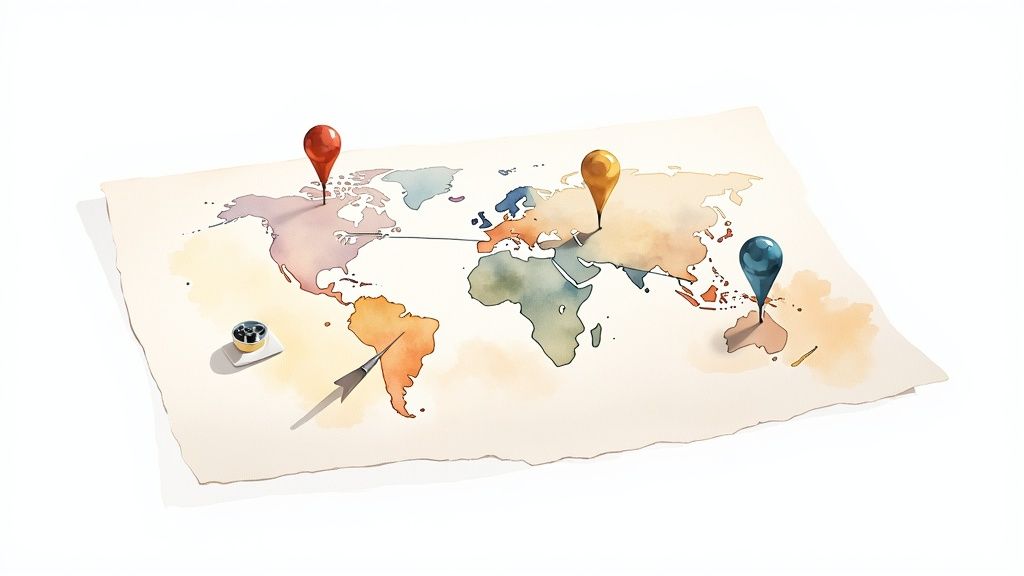Questionnaire vs. Survey: Stop Confusing the Weapon With the War Plan
Discover the difference between questionnaire and survey and learn when to use each for clear, actionable insights.
Posted by
Related reading
Your Customer Feedback Is Worthless
Stop making decisions with bad data. This guide exposes bias in survey questions and gives you a playbook to get customer feedback that isn't garbage.
Your Survey Data Is a Goldmine Full of Landmines
Stop guessing. Learn how analysing survey data the right way turns messy customer feedback into actionable growth strategies for your startup.
You’re Asking Your Mom If She Likes Your Idea. Stop It.
concept testing questions that help you validate ideas fast. Learn 6 practical prompts to avoid risky bets and sharpen your product concept.
Your last "customer survey" was a waste of time. I know because mine used to be, too. You threw ten questions into a Google Form, emailed it to your five friendliest users, and called the three polite replies you got "data."
That’s not data. It’s a vanity project. It’s like calling a hammer a house. You’re just holding the tool, patting yourself on the back for doing something, and wondering why you’re still sleeping in the rain.

Let's cut the crap. The difference between a questionnaire and a survey isn't academic—it's the difference between collecting noise and gathering intelligence. A questionnaire is just the list of questions. A survey is the entire mission: defining the target, deploying the questions, and analyzing the hell out of the responses to find the one truth that could save your company.
Ignore your customers, and you’ll be lucky to survive the quarter. Listen to them the wrong way, and you'll build a perfect product for an audience of zero. You're collecting disconnected facts when you should be hunting for patterns. The U.S. Census Bureau distributes questionnaires, but the value is in the survey—the ruthless aggregation of 330 million responses to spot trends that decide billion-dollar budgets.
Your handful of responses isn't a trend. It's an anecdote.
Questionnaire vs. Survey: The No-BS Breakdown
Stop looking like an amateur in your next pitch meeting. Memorize this table.
| Attribute | Questionnaire (The Tool) | Survey (The Process) |
|---|---|---|
| Purpose | Gathers data on an individual. | Gathers data to analyze a group. |
| Scope | Standalone list of questions. | The entire research project from start to finish. |
| Output | A single completed form; a collection of answers. | Aggregated data, trends, and actionable insights. |
| Analysis | None. It's just raw data. | Requires statistical analysis to find real meaning. |
A questionnaire tells you User #582 didn’t like your font. A survey tells you why 40% of users drop off after onboarding. One is a distraction; the other is a roadmap.
Takeaway: A questionnaire is the weapon; a survey is the battle plan. Don’t bring a knife to a gunfight.
The Questionnaire: A Surgical Strike
A questionnaire is a scalpel. You use it for one thing: getting a specific piece of information when the bigger picture is irrelevant. You’re not hunting for a trend; you’re closing a transaction.

Think about the forms you fill out every day. Medical intake, job applications, bug reports—all questionnaires. The point is to understand one person or one event in isolation. It's raw information retrieval. No grand analysis, no p-values, no debating sample size, because your sample size is one.
Use a questionnaire when the task is transactional:
- Onboarding a new client: You need their billing info. That's it.
- Processing a return: Order number, reason. Done.
- Filing a bug report: Browser version, OS, steps to reproduce. Closed ticket.
Sending questionnaires and thinking you’re gathering market intelligence is a rookie mistake. You're just filling a database with disconnected facts. If you want to master this tool, learn how to create a questionnaire that does its one job perfectly without pretending to be something it’s not.
A questionnaire is for logging data, not interpreting it. Don’t use a scalpel to chop down a tree.
Takeaway: Use a questionnaire for transactional data, not strategic truth.
The Survey: Your Battle Plan
A survey is a full-scale military operation. It starts with a mission-critical objective—a painful business question you have to answer or die. Why did last month's cohort churn twice as fast? Should we bet the next six months of runway on this feature?
The questionnaire is just the weapon you deploy. Victory comes from the strategy behind it.

A real survey means defining your target population with ruthless precision—not just blasting your email list. It means designing questions that dig for brutal truths, not fishing for compliments. Then comes the part everyone skips: the cold, hard analysis of the collective data.
A survey is what tells you why 40% of your users bail after onboarding. A questionnaire just tells you User #582 hates the color blue. One reveals a strategic weakness; the other is noise.
The output of a survey isn't a spreadsheet; it's a decision. It’s the difference between guessing where the enemy is and having satellite imagery of their exact location. If you want to get a real pulse on your team, a comprehensive culture survey guide shows you how to do it systematically.
Don’t launch a survey unless you’re ready to act on what you find. Otherwise, you’re just cosplaying as a CEO.
Takeaway: Run a survey only when you need to make a strategic decision based on group behavior.
How Digital Tools Made Us Lazy Idiots
Years ago, launching a survey took discipline. It was expensive and slow, forcing you to be damn sure you were asking the right questions. You couldn't just "whip something up."
Now, tools like SurveyMonkey make it dangerously easy to spam people with questions. We’ve mistaken speed for strategy. We think because we can launch a form in ten minutes, the data is automatically valuable. It’s not. It’s garbage.
These platforms automated the instrument (the questionnaire) and its distribution. They can't automate the critical thinking that turns random questions into a real survey. The ease of use is a trap. It makes you feel productive while you’re just collecting noise.
Modern tools spit out pretty charts and founders think they’ve struck gold. That’s not analysis; it’s data visualization. The hard work—figuring out if those charts mean anything—is still on you.
Historically, the difference between a questionnaire and a survey was obvious because the process forced you to think. Today, software from vendors like Alchemer blurs those lines. Gartner reports over 70% of enterprises use integrated software for both, making it easier than ever to confuse the two.
Relying on these platforms as a complete solution is like using a calculator and calling yourself a mathematician.
Takeaway: Easy tools create lazy thinking. A pretty chart is not an insight.
Diagnosing vs. Strategizing: Pick Your Play
Stop asking, "Should I send a survey?" That’s the wrong question. Ask this instead: "What decision do I need to make right now to keep this company alive?"
Think of it this way:
If you need to diagnose a single, specific issue ("Why did User #123's payment fail?"), use a questionnaire. It’s battlefield medicine. Targeted data, fast. It’s tactical.
If you’re making a huge strategic bet ("Should we invest six months of runway into building this feature?"), you need a survey. This is your war plan. You need to see the entire landscape, not just one soldier's view. Getting this right is the core of customer feedback management.
The deadliest mistake is using a questionnaire to drive a strategic decision. That’s how you build a feature for one loudmouth customer while the silent majority—the ones who pay you—quietly churn.
Are you performing field surgery or planning an invasion?

The flowchart makes it painfully clear. Diagnose a specific problem with a questionnaire. Make a broad, strategic move with a survey.
Using a questionnaire for a strategic decision is like asking a single person for directions and then betting your company on their route. It’s not data-driven; it’s reckless.
Takeaway: Diagnose individual problems with a questionnaire; place strategic bets with a survey.
FAQs From the Trenches
Still skeptical? Good. That’s how you survive. Here are the straight answers to the questions you're afraid to ask.
So a Questionnaire Is Always Part of a Survey?
Yep. The survey is the entire mission. The questionnaire is just the list of questions you use on that mission. You can't have a survey without a questionnaire, but you can fire off a questionnaire all by itself. It’s a chapter versus a book.
Is a Feedback Form a Questionnaire or a Survey?
99% of the time, it’s a questionnaire. That "How was your support experience?" pop-up is collecting one data point. It’s a standalone tool. It only becomes part of a survey when you aggregate all the feedback and analyze it for patterns. Finding out that "Support agent Bob has a 20% lower satisfaction score on billing tickets" is a survey insight. That insight leads to a decision: retrain Bob. Now you're using data, not just collecting it.
What’s the Biggest Mistake Founders Make With This?
Confusing a high volume of responses with a valid survey. They get 1,000 answers to a lazy question, see that 70% chose "Option A," and pivot their entire roadmap. They never stop to ask: Were these the right 1,000 people? Was the question biased? Does "Option A" mean what we think it means? They see data collection as the finish line when it’s the starting pistol. Don't confuse activity with progress.
How Do I Stop Sucking at This and Build a Real Survey Strategy?
Start with one, painfully specific business question you can't answer. Not "What should we build next?" but "Why have 30% of trial users from the last 60 days failed to convert?" Work backward. Who do you need to ask? What do you need to know? How will you confirm the data isn't garbage? The goal isn't to get answers; it's to get the right answer.
Takeaway: The goal is the decision you make after the analysis, not the pile of data you collect.
Stop asking your customers dumb questions and let Backsy uncover what they really want by analyzing what they already told you.